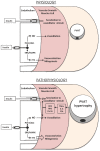Oxidative stress in diabetes: implications for vascular and other complications
- PMID: 24177571
- PMCID: PMC3856020
- DOI: 10.3390/ijms141121525
Oxidative stress in diabetes: implications for vascular and other complications
Abstract
In recent decades, oxidative stress has become a focus of interest in most biomedical disciplines and many types of clinical research. Increasing evidence shows that oxidative stress is associated with the pathogenesis of diabetes, obesity, cancer, ageing, inflammation, neurodegenerative disorders, hypertension, apoptosis, cardiovascular diseases, and heart failure. Based on these studies, an emerging concept is that oxidative stress is the "final common pathway" through which the risk factors for several diseases exert their deleterious effects. Oxidative stress causes a complex dysregulation of cell metabolism and cell-cell homeostasis; in particular, oxidative stress plays a key role in the pathogenesis of insulin resistance and β-cell dysfunction. These are the two most relevant mechanisms in the pathophysiology of type 2 diabetes and its vascular complications, the leading cause of death in diabetic patients.
Figures



References
-
- D’Autreaux B., Toledano M.B. ROS as signalling molecules: Mechanisms that generate specificity in ROS homeostasis. Nat. Rev. Mol. Cell Biol. 2007;8:813–824. - PubMed
-
- Ibrahim W., Tatumi V., Yeh C.C., Hong C.B., Chow C.K. Effects of dietary carnosine and vitamin E on antioxidant and oxidative status of rats. Int. J. Vitam. Nutr. Res. 2008;78:230–237. - PubMed
-
- Valdivia P.A., Zenteno-Savin T., Gardner S.C., Aguirre A.A. Basic oxidative stress metabolites in eastern Pacific green turtles (Chelonia mydas agassizii) Comp. Biochem. Physiol. Toxicol. Pharmacol. 2007;146:111–117. - PubMed
-
- Camera E., Picardo M. Analytical methods to investigate glutathione and related compounds in biological and pathological processes. J. Chromatogr. Anal. Technol. Biomed. Life Sci. 2002;781:181–206. - PubMed
-
- Tarpey M.M., Wink D.A., Grisham M.B. Methods for detection of reactive metabolites of oxygen and nitrogen: In vitro and in vivo considerations. Am. J. Physiol. Regul. Integr. Comp. Physiol. 2004;286:R431–R444. - PubMed
Publication types
MeSH terms
LinkOut - more resources
Full Text Sources
Other Literature Sources
Medical

